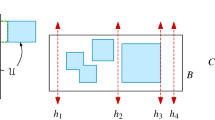Abstract
We study the functionb(n, d), the maximal number of atoms defined byn d-dimensional boxes, i.e. parallelopipeds in thed-dimensional Euclidean space with sides parallel to the coordinate axes.
We characterize extremal interval families definingb(n, 1)=2n-1 atoms and we show thatb(n, 2)=2n 2-6n+7.
We prove that for everyd,\(b^* (d) = \mathop {\lim }\limits_{n \to \infty } b(n,d)/n^d \) exists and\(1 \leqq (d/2)\sqrt[d]{{b^* (d)}} \leqq e\).
Moreover, we obtainb*(3)=8/9.
Similar content being viewed by others
References
D. R. Fulkerson andO. A. Gross, Incidence matrices with the consecutive l’s property,Bull. Amer. Math. Soc. 70 (1964), 681–684.
M. C. Golumbic,Algorithmic Graph Theory and Perfect Graphs, Academic Press, 1980.
B. Grünbaum,Arrangements and spreads, Amer. Math. Soc., Providence, 1972.
A. Gyárfás, J. Lehel andZs. Tuza, The structure of rectangle families dividing the plane into maximal number of atoms,Discrete Mathematics 52 (1984), 177–198.
R. Rado, Atoms of families of sets,Combinatorica 2 (1982), 311–314.




